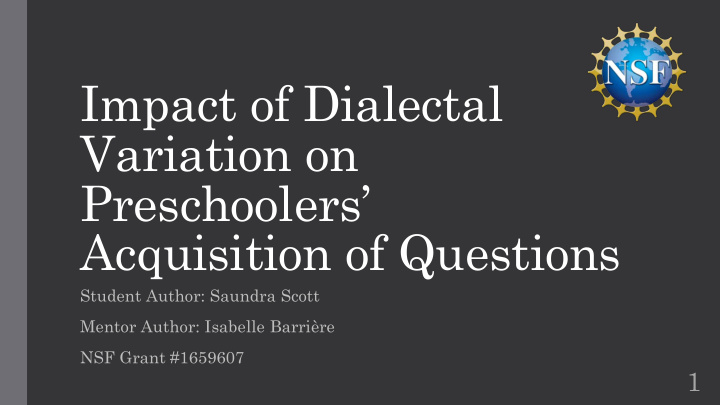



Impact of Dialectal Variation on Preschoolers’ Acquisition of Questions Student Author: Saundra Scott Mentor Author: Isabelle Barrière NSF Grant #1659607 1
Introduction • What is Mainstream American English (MAE)? dialect of English that most Americans speak. • What is African American English (AAE)? dialect typically used by working-class African Americans. • Regional differences of AAE in different parts of the U.S. (e.g. New Orleans, Detroit, New York City, Chicago, etc.) (“ Talking Black in America ,” 2017). • In more diverse and/or less segregated environments speakers combine features of both MAE and AAE. 2
Key concepts Copula : A word that links the subject of a sentence with • a predicate. He is a doctor Auxiliary : word that often combines with to main verb to • indicate tense and aspect: She is jumpi ng vs She has jump ed • Inversion Process : Moving the auxiliary verb before the subject in a sentence; occurs in the formation of questions: she is jumping Is she jumping? 3
Question-formation in MAE and AAE Speakers of MAE typically use the inversion process (in questions) while speakers of AAE do so less frequently (Green, 2007). e.g.: We almost done? (Green, 2011) Speakers of AAE delete auxiliaries and copulas (Wolfram, 2013). e.g.: what is he doing? what ø he doing? (auxiliary deletion; AAE) e.g.: who is she? who she? (copula deletion; AAE) 4
Question formation in children acquiring MAE and AAE: Theakston & Rowland (2009) and Rowland & Theakston (2009) used games to elicit auxiliaries in children 2;10- 3;6 (years;months) acquiring British English. Production of questions in young children acquiring AAE in segregated areas reflect adult AAE grammar (i.e. high rates of non-inversion and deletion of copulas and auxiliaries) (Green 2011). 5
Research Question • NYC low SES preschoolers: relatively less segregated ; acquire different varieties of English including MAE and varieties that slightly (Some Variation) or greatly (Strong Variation) differ from MAE (Barrière et al., 2018) • What is the pattern of acquisition of Yes/No and WH-questions in children exposed to different varieties of English? 6
Participants • Data set 1: Narratives (Frog Story) N= 14; 3- 5 year olds (Barrière et al, 2018) • Data set 2: Hedbanz and Guess Who games N= 8 ; 3;6-5 year olds • Enrolled in Head Start/ Preschool with vouchers (low SES) • No developmental issues; less than 10% exposure to Languages Other Than English • 3 Groups: MAE, Some Variation, Strong Variation, determined based on Diagnostic of Language Variation Screener (DELV, Seymour et al., 2005) 7
Grammatical Section: sentence completion task DELV Screener • 3 rd person singular have/has: Have/has; got is included. Indicates the language variation status of the He has ( MAE ) vs. He have/got ( AAE ) participant. • 3 rd person singular -s, -es: Section 1: Focuses on He sleep s ( MAE ) vs. he sleep ø phonology: sentence ( AAE ) repetition E.g. I see her brushing • 3 rd person singular do/does: her tee th (MAE)/ tee f He do/don’t ( AAE ) vs. (AAE) . He does/doesn ’ t ( MAE ) • Copula or (auxiliary) was, were: They were ( MAE ) vs. They was ( AAE ) 8
Tasks developed for this project • Guess who and adaptation of Hedbanz: fosters the production of yes/no questions and wh-questions. Guess Who? ( figure 1 ) Figure 1 : Guess Who? • Objective: have the participants guess the person that each player has; cards represent the person that has to be guessed; opponents can only ask yes/no questions. Adaptation of Hedbanz game (figure 2) that involves 18 cards. 3 questions are allowed on each card: (e.g. Is it a fruit/food? What shape/color is it?; Is it a thing?) • The experimenter models yes/no questions or wh- Figure 2 : Hedbanz questions with MAE structure (i.e. inversion; presence of 9 copulas and auxiliaries).
Data Analysis • Tasks 1-3 ( DELV screener ): scoring sheets; also audio- recorded (100% inter-coder reliability of 2/3 of samples). • Tasks 4-5 ( Guess Who and Hedbanz ): audio-recorded and transcribed in the CHAT (CHILDES) (MacWhinney 2000) format (figure 3) . The program called CLAN was used to transcribe the data. Figure 3 : CLAN (MOR). MOR gives an 10 grammatical analysis.
Data Analysis Analyzes focus on structural • characteristics of questions: Also focuses on how often • and whether there are changes in word order along with the production of the copula and the auxiliaries. Similarities and differences • between the acquisition of Combo (CLAN) (MAcWhinney, 2000) : MAE, Strong Variation and shows an output of specific items; shows Some Variation. how often the participant produces it. KidEval (CLAN) : excel sheet that shows an output of total num. of auxiliaries, articles, 11 copulas, utterances, etc.
Results Inversion Process in MAE, Some Variation and Strong Variation Confirm predictions 100% re: rates of non- inversions: 96% 90% 80% Strong Variation > 70% Some Variation > 70% MAE 60% 50% 50% 40% 30% 20% 10% 0% MAE Some Strong Variation Variation 12
Presence of Auxiliary and Copula in MAE, Some Variation and Strong Confirm Variation predictions re: rates of auxiliaries and 91% copulas in 78% 80% questions: MAE > Some Variation > 50% Strong Variation 38% 25% AUX COPULA AUX COPULA AUX COPULA MAE SOME VARIATION STRONG VARIATION 13
Broader Impact • Study would help Speech Language Pathologists (SLPs) and teachers to understand that there are different dialects in English. • Making sure that the child is not diagnosed with a speech disorder when it is just a dialectal variation of a language. 14
Acknowledgements Special thanks to: • Yeled V’Yalda and LIU Brooklyn - the parents, teachers and participants. • Research Assistants: Nargizakhon Yunusova, Katsiaryna Aharodnik, and Chana Karp. • Thank you to The National Science Foundation (NSF Grant #1659607) for funding this program (ILLC) and NSF BCS#1548147 to I. Barrière 15
Recommend
More recommend